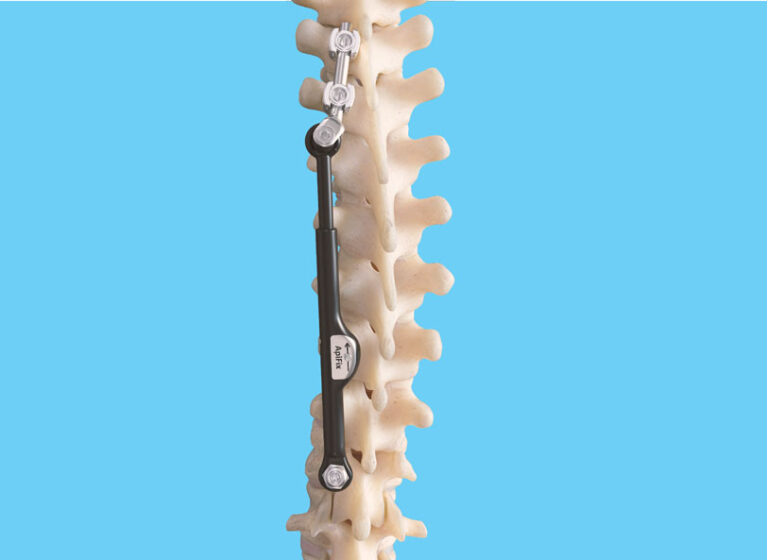
UVA Health is helping to make more care options available for children with scoliosis.
We’re participating in a study for ApiFix®, a ratcheting, expanding rod for growth modulation in pediatric scoliosis. Because the rod can grow with the patient, it’s a good option for those needing a solution in younger patients for whom spinal fusion isn’t the right choice.
The first surgery, performed by Anuj Singla, MD, a pediatric spine surgeon and scoliosis expert at UVA Health, was done at the beginning of September. Singla is a principal investigator on this study as well as on another UVA Health scoliosis non-fusion study.
Better Spine Treatments Through Research
At UVA Health, we’re always looking to expand the possibilities for all patients. Our surgeons are certified and trained in the full range of scoliosis care, including non-fusion techniques. “We’re one of the study sites for a casting versus bracing and early-onset scoliosis national trial,” says Keith R. Bachmann, MD, also a pediatric orthopedic surgeon, scoliosis specialist, and co-investigator on the study at UVA Health.
UVA Health is one of only 20 institutions across the U.S. that are participating in the ApiFix study. “We are one of the very few centers around the United States who have been approved for this clinical trial,” says Singla.
The ApiFix device is “able to be deployed and used on patients across a broader age spectrum than some of the other growth-friendly devices,” notes Bachmann.
UVA Health is part of the Harms Study Group, an international association of researchers who advance the care and understanding of spinal deformities. “If there's something modern that's being done for scoliosis, we're probably doing it here at UVA,” says Bachmann.
A Ratcheting Rod Supports the Spine
ApiFix has received a humanitarian use device exemption from the FDA. It works by serving as a kind of buttress on the spine that prevents it from growing at an incorrect curvature.
The device is a rod that’s attached to 2 points on the spine. The rod is expandable and can get longer. However, it includes a ratcheting mechanism that can keep it from getting shorter. This allows the device to grow with the patient. “The benefit of fusion versus not using a device is pretty obvious. We are not fusing the spine, so the spine does not lose any motion. The spine stays flexible, and it does not have any big degeneration or arthritis risk in the future,” explains Singla.
“That's really all dependent on the patient's growth and movement,” agrees Bachmann. “With ApiFix, the special components, if you will, are that ratcheting, telescoping rod, so they can keep up with growth. They get a little bit more correction and it will help them maintain that correction. But the other part is independent mobility of the device in relation to the spine. It maintains that ratchet while still allowing the patient to have some mobility.”
Patients participating in the study are also enrolled in a registry that tracks their outcomes over time. “The registry captures the patient’s de-identified information about the amount of curve they have, the curve flexibility, and what kind of procedures they’re getting,” says Singla. Besides documenting the patient’s preoperative data, it also notes how much correction was achieved with the surgery as well as tracking the amount of correction they have over the 2 years the patient is tracked in the registry.
Turning to Surgery When Bracing Failed
The first patient, an 11-year-old girl, initially was treated with a brace. Unfortunately, bracing didn’t work for her. “When I saw her, she had a small thoracic scoliosis. Like any other young patient with mild scoliosis, she was started with a brace,” says Singla about the patient’s early course of treatment. “It seemed absolutely perfect to get the correction, but it did not hold her spine in the correct position for a long time.”
Because the brace didn’t work, the patient’s scoliosis got worse over the next 2 years. According to Singla, surgery was the next step.
With the surgery and 2 months of recovery now behind her, Singla is optimistic about the patient’s spinal correction. “Oh, she’s doing wonderful. She's very happy,” Singla says. “I saw her at about 4 or 5 weeks from the surgery, and she already heard three clicks — that would be, she already grew or she already corrected her spine by three millimeters.”
Simpler to Put in Place
Unlike some other growth modulation devices, the ApiFix device is simpler to put in place and maintain.
“It's a posterior approach. We go in through the back, which is what we do for the current gold standard of care, posterior spinal fusion,” notes Bachmann. “It, therefore, doesn't impact the lungs.
“So it's a familiar approach, in that respect. If in the long term there is a fusion or any sort of posterior surgical solution that needs to be done, that posterior approach to the thoracic spine is the most common approach that we're going to use,” he says.
Singla agrees. “It’s a very small surgery that does not require any special equipment or any special surgical access. And that’s one of the advantages.”
Another Solution for Growing Bodies
Bachmann sees some definite benefits with the device. “It's a shorter surgery. It's a shorter hospital stay, and there is less blood loss because there are fewer anchor points to the spine. There's less dissection,” says Bachmann. “But it means that we have less control over deformity correction of the spine, for example. But, that may be a trade-off that the family or for patient really wants.”
“The first case is always the toughest to get by,” comments Singla. “But as we start to see better results over time, and if the results are sustained and the patients seem to get better, we will feel more comfortable offering this procedure to more patients. And I think in the next few months we will be open to enrolling more patients in the same registry.”